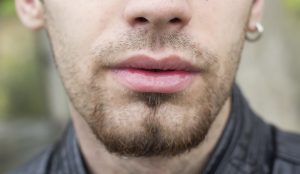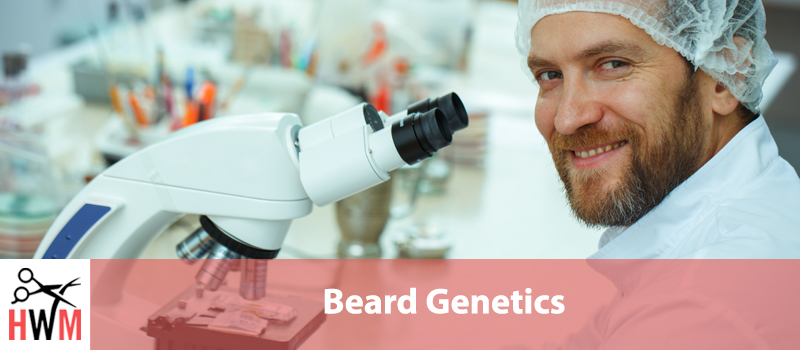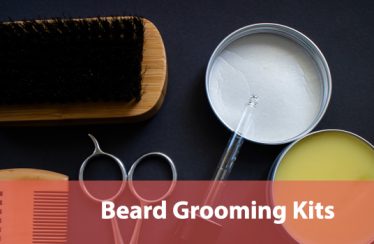Time for some real-talk. Your genetic makeup influences just about everything about you. That means the color of your skin, the color of your eyes, how tall you are. Of course, it also has a big role to play in how your beard grows, too.
So, while it’s fashionable at the moment to have a thick well-groomed beard, you may be wondering if you have the right set of genes to make it happen.
We’ll talk about beard genetics, what it can influence, and the different timelines different people have for growing fantastic facial hair. We don’t have all the answers, and there aren’t miracle drugs that fix your genetic pre-dispositions. But we can give some advice on how to encourage your chin to grow the whiskers you’ve dreamed of.
- It’s Genetic. Who do You get it From?
- What Impacts Beard Growth – From a Genetic Perspective
- Be Proud of Your Heritage
- Hack Your Beard – Your Genetics Aren’t the End of the Story
It’s Genetic. Who do You get it From?
As with most genetic factors, one of the first things we wonder is who we should look at. Male pattern baldness, for instance, mostly travels down your mother’s family since it’s carried on the X chromosome. Eye color, however, is less specific. It can come from either parent and may be a mix of traits from different genes.
Your genes also have a combination of dominant and recessive traits. If one of your parents has blue eyes, and the other has brown eyes, you’re a little more likely to have brown eyes. That’s because you’re most likely to get brown eyes if you have one of each type of gene.
That’s a little too simple, of course. Different genes interact with one another in complex patterns. Just because you have a particular gene doesn’t mean you’ll have that gene’s traits. How your genetic code is expressed is a combination of the genes you have and your epigenetic markers.
Epigenetics is the study not of the genes themselves, but of how genes are expressed. Just because you have a gene doesn’t mean it’s always on or always working. But gene expression isn’t entirely circumstantial or responsive. Some of your epigenetic code also comes from your parents and can be influenced by their experiences and choices.
What does all of this have to do with beards? Well, it’s hard to say since the genes responsible for beard growth and thickness aren’t known. But it illustrates how complex anything genetic can become.
We wish we could tell you which parent gave you your beard genetics, but we can’t.
That doesn’t mean that looking to your family for example of how your genetics play out isn’t a good idea. It is. You should be looking at your male family members for examples of how their hair and facial hair tends to grow.
Have an uncle with a permanent 5 o’clock shadow? Ask him when he first started to get facial hair and when it started to grow so quickly. Chances are those two things started at very different times.
Look at your dad. Does he shave every day? Does he rock a distinguished beard? A set of lumberjack whiskers reaching to his chest? That may be a good indicator of what you can expect. But he may not have gotten that facial hair until his 30’s, or even later.
Some basic questions you should ask family members:
Q: When did you first start growing facial hair?
Q: Was your facial hair patchy or uneven at first?
Q: Have you ever noticed big changes in your facial hair?
Q: What products do you use to help grow and maintain your facial hair?
Don’t worry, you don’t need to directly ask your relatives these questions if that’s uncomfortable. Just keep them in mind looking at family photos, or at family gatherings.
You’ll be surprised how much you can learn about your family members, including their facial hair and favorite grooming routines, with a little sleuthing.
Look at Both Sides of the Family

It may seem most natural to look at your dad and your dad’s family. After all, facial hair is mostly a masculine trait. But you can look at your mother’s relatives as well. Even your female family members can have traits related to your beard growth.
For instance, if she bleaches a slight mustache or occasionally shaves some unwanted facial hair, that can be an indicator that you have genes for more facial hair growth.
That’s because the hormones and hair follicles required for facial hair are present for everyone. Growing facial hair is a combination of the right hormone levels and sensitivity to those hormones. So, your female relatives may also experience hair growth or lack of hair growth.
The more close relatives you have, the more data you have for what to expect. Look at your parents, grandparents, aunts and uncles, and your cousins. The more closely related you are, the more likely your experience will match theirs. Your father and brothers are probably the best examples, but they aren’t an exact roadmap thanks to the complexities of genetics.
What Impacts Beard Growth – From a Genetic Perspective
Several different factors can impact beard growth, color, and texture. Not all of these are directly related to beard growth, so bear with us. We’ll always explain how these things influence beard growth.
Testosterone
The amount of testosterone your body produces has a big role to play in how much facial hair you will grow. Since testosterone is one of the most important hormones in your body, it affects a wide variety of processes.
While not everyone has gotten their testosterone levels tested, this is one of the things you can look at family members to help determine. If the men in your family tend to have some scruff, even after they’ve shaved, have a high metabolism, bulk up easily, or suffer from male pattern baldness those are all signs of possible higher testosterone.
How much testosterone you have isn’t the only factor? Other genes that play an important role in testosterone and beard growth determine how sensitive you are to testosterone. Like many things, testosterone and androgen sensitivity is a scale.
Lower testosterone levels, by itself, doesn’t mean you can’t grow facial hair. By the same token, higher levels of testosterone don’t guarantee good facial hair unless you’re also responsive to it.
While testosterone is genetic, there are plenty of other things you can do to help boost your testosterone and your responsiveness.
We’ll talk about that a little later. But, if you’re concerned about low testosterone, talk with your doctor. They may be able to test your T levels and recommend appropriate treatments if needed.
Color

The color of your beard is also mostly genetic (unless you color it that is!). Graying hairs can be brought on early by stress or nutrition among many other factors. But, the main color of your beard before you go gray is largely genetic.
Your hair and beard color may closely resemble your parents, or it may look like a mix of the two. Or, you may get a seemingly random hair color, like black hair with a blonde- and brown-haired parents.
You’ll probably also notice that your hair and your beard aren’t exactly the same color.
It’s common for your genes to express differently in your hair and beard. One common variation is for men to have more red in their beard than they have on top of their heads. But other differences are similarly common.
A slightly darker beard, but in the same general color, is perfectly normal. So are beards that are a little lighter than the hair on top of your head.
While this is an easy trait to change, the original color of your hair is mostly genetic.
Hair Growth Rate
While there are average growth rates for most people, the actual rate of your hair and facial hair grows is highly individual. Your growth rate isn’t necessarily connected to how much hair you have but can make a big difference in how quickly you’re able to go from a little scruffy to rivaling Gandalf.
Hair growth between ¼ inch and ½ inch is normal. It’s possible to grow a thick beard, but have it grow in a little slower. Or, you may have a patchy beard that grows quicker than normal.
It’s only one factor. But your hair growth speed is important to consider in how you shape and care for your beard.
Stress Response
This is one of those things that isn’t directly related to your beard. But your genetic stress response is one more important factor in beard growth.
Like the rest of the hair on your body, you can experience facial hair thinning and fallout when you’re dealing with a lot of stress. It can also grow in more slowly if you’re under chronic stress.
But you may be more vulnerable to stress depending on a variety of genetic and epigenetic factors. But, if you have a genetic predisposition to a more pronounced stress response, that response may get in the way of your facial hair growth.
While stress response is only partially genetic, it’s more strongly influenced by epigenetics. If your parents are veterans or had experienced other types of trauma and high-stress situations, you may be more prone to high-stress responses.
This is also true if your parents have anxiety or another mental health disorder. Don’t worry. Since stress response is only partially genetic, this is something to keep track of. But parents with high-stress response isn’t necessarily a predictor for your mental state and mental health.
Hair Follicle Density

This is one of the biggest direct predictors of the thickness and growth of your facial hair.
Hair follicles grow everywhere in your skin, but the type of hair they grow, and how fast they grow it, depends on lots of other factors. Men develop facial hair thanks to hair follicles being stimulated by a form of testosterone.
Dihydrotestosterone, which is produced naturally by your body, is a more potent form when it comes to hair growth and facial hair growth. Dihydrotestosterone (DHT) is also one of the most important hormones when it comes to male pattern baldness.
We’ll cover DHT in more detail in the next section, but it’s important to remember that DHT has different effects on different hair follicles.
The number of hair follicles you have on your face, and the density of those hair follicles, is the ultimate determinant for how thick and full you can grow your facial hair.
There are procedures available to increase the number of hair follicles on your face. A hair follicle transplant can be performed on your facial hair just like it can be done on the crown of your head.
However, short of having a transplant, there is no way to stimulate more hair follicles to grow in your skin. Instead, growth treatments focus on helping repair your hair follicles and encourage growth.
A dermatologist can look for your density and the number of hair follicles on your chin. Some may want to take a hair follicle biopsy to check for damage and other factors that impact how many active hair follicles you have.
DHT
DHT has a wide variety of effects on your body. It’s one of the hormones that determine body hair growth. The amount of testosterone your body converts to DHT increases with time. Starting around puberty, when your body begins producing more and more testosterone, it will slowly begin converting some of that testosterone to DHT.
DHT is more potent than regular testosterone. It encourages faster, thicker hair growth in some hair follicles. It can also discourage hair growth in others.
High concentrations of DHT can lead to better facial hair, especially if your hair follicles are also responsive to DHT. But, the hair on top of your head is also sensitive to DHT, just with the opposite effect.
High levels of DHT, or high sensitivity to DHT, can both contribute to male pattern baldness. Meanwhile, that same DHT is stimulating your facial hair, or your body hair, to grow in thicker and faster.
DHT is hard to predict. We know that one of the actions of finasteride, or Propecia, when used for hair loss is to lower the concentrations of DHT in your scalp.
Terminal Length
Another genetic factor to your beard growth is something called terminal length. Now, terminal length is not entirely genetic. It can also be impacted by the products you use and your hair and beard care routine.
But, terminal length refers to the longest length your hair can reach naturally. For most people, this length is determined by how fast your hair grows vs how fast it breaks or falls out. Individual strands of hair get replaced over time. But breakage and split ends can make your hair shorter even before the strand is replaced by new growing hair.
Your beard will, if you grow it out for a long time, eventually reach a point where it doesn’t get any longer.
Terminal length is different for everyone. This is one of the things you can look to family members for a good example. Assuming you have similar grooming routines and habits, they are most likely to have similar genetic factors. That means that family members’ terminal hair length is likely to be similar to your own.
Age
While your age is obviously not genetic, your genetics can impact what age your body starts to grow facial hair.
Some men get full, enviable, beards while still in their teens. That’s a genetic trait. But, other men won’t be able to grow good facial hair until they’re in their 30’s. For some men, it can be even later than that.
Fortunately, this one is a little easier to predict. Your facial hair is likely to start growing within a few years of the time your dad’s facial hair started growing, or your brother’s.
So, even if you can’t grow a great beard right now, you may just need to wait a few years for the concentration of DHT produced by your body to increase. There’s no shame in growing into your beard a little later.
After all, the biggest difference is that you’ll have the experience to go with the dignity of your new beard.
Be Proud of Your Heritage
Whether or not the men in your family rock their facial hair, or shave it clean, they probably have some stories to tell. Whether their mad mutton chops attracted their first serious girlfriend, or they were seriously relieved to shave off the beard they grew overseas, it’s worth asking about the styles they rocked and why.
Look through family photos. Retro facial hair is a serious fad, so you may get some inspiration. But, more importantly, you can learn about the past from the styles people adopted.
Have a bright red beard out of nowhere? Probably there’s a grandfather or an uncle somewhere on your family tree with a similarly bright beard.
The shape, color, thickness, and terminal length of your beard can also be indicators of your heritage. Where ever you come from, your facial hair can be a way to connect to all the people who came before you.
We’re not just talking about big glorious beards, either. Even if all you can grow is a little bit of stubble or a mustache without a beard or chops, you’re still the product of thousands of years of genetic success.
We’ve spent a lot of time talking about how your genetics can impact your ability to grow facial hair. But, you should be proud of your facial hair whether it’s a Dumbledore length beard, or hardly there at all.
Hack Your Beard – Your Genetics Aren’t the End of the Story

While we’ve spent this whole article talking about how genetics impact your beard growth or lack thereof, there are a few things you can do to try and encourage better growth.
Take a Multivitamin and a Beard Growth Supplement
One of the best things you can do for your facial hair, along with the rest of you, is to take a good multivitamin and a good beard supplement.
Nutrition is critical to good beard growth. While getting complete nutrition from your diet is preferable, it’s not always possible. Nutrients like vitamin D are hard to get in your diet without additional supplementation.
Multivitamins will help make sure you don’t have any gaps in your nutrition. It can take a couple of months to show the full benefits of taking a multi. That’s because it takes time for missing nutrients to build back up in your system.
A beard growth supplement, on the other hand, focuses on the specific nutrients you need for healthy hair growth. That can help raise your vitamin levels faster and targets the vitamins most important for your skin and hair follicles.
Exercise

We’ve talked about how testosterone impacts your facial hair. Exercise, aside from helping you feel and look better, is also a good way to raise your testosterone.
While the conversion from testosterone to DHT is still largely a product of your genetics and your age, raising your overall testosterone levels can help.
Regardless of whether exercise causes a significant improvement to your facial hair, it’ll help boost your confidence.
Use Beard Grooming Products
While beard grooming products can’t help you grow more hair follicles or radically alter your beard overnight, they can help improve the appearance of most facial hair.
Moisturizing products like beard oils and balms are some of the most important. They’ll help protect your facial hair, mitigating damage, and helping it grow longer without split ends and breakage.
The right moisturizing products will also help improve the health of your skin, which will minimize breakouts and help your hair follicles get the nutrition they need.
Other beard grooming products, like cleansers, shampoos, and conditioners can also help you keep your face and facial hair clean, minimizing irritants that interfere with normal hair growth.
Look for products with ingredients that stimulate circulation like mint, rosemary, cinnamon, or eucalyptus.
Conclusion
Facial hair is a sign of health, virility, and masculinity. But it isn’t everything. Whether you have amazing facial hair or struggle to grow a whisker, you can be exactly the person you want to be.
Genetics play a big role in facial hair. There’s no getting around it, and no replacement for good hair genetics. But, pride in your heritage, whether it comes with a beard or without one, is always a good look.




